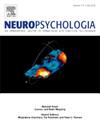Neural and perceptual adaptations in bilateral macular degeneration: an integrative review
IF 2
3区 心理学
Q3 BEHAVIORAL SCIENCES
引用次数: 0
Abstract
Bilateral age-related macular degeneration (AMD) results in central vision loss, affecting the fovea-associated cortical regions. This review examines neuroimaging and psychophysical evidence of spontaneous neural adaptation in acquired bilateral central scotoma. Early visual brain areas show reduced cortical thickness and axonal integrity due to postsynaptic (anterograde) degeneration. Contrary to animal models, evidence for spontaneous adaptation in the primary visual cortex (V1) is limited. Activity in the lesion projection zone (LPZ), previously seen as extensive cortical remapping, may result from non-retinotopic peripheral-to-foveal feedback, sharing substrates with healthy retinal feedforward processes.
Preferred retinal loci (PRLs) are influenced more by location and task than by residual vision quality. Reduced lateral masking in the PRL may reflect decreased contrast sensitivity from retinal damage, rather than genuine adaptive mechanisms. Weakened crowding in the PRL is explained by transient adaptation in healthy subjects to artificial scotomas, not by long-term plasticity. Higher visual areas may show compensatory mechanisms enhancing complex tasks like symmetry, face, and motion discrimination. Leveraging spontaneous adaptation through perceptual learning-based treatments can preserve residual visual abilities. Because of limited evidence for spontaneous reorganization in AMD, behavioural training and emerging techniques are crucial for optimal treatment efficacy.
双侧黄斑变性的神经和知觉适应:综合综述。
双侧年龄相关性黄斑变性(AMD)导致中央视力丧失,影响中央凹相关皮质区域。本文综述了获得性双侧中央暗斑自发性神经适应的神经影像学和心理物理证据。由于突触后(顺行)变性,早期视觉脑区显示皮层厚度和轴突完整性降低。与动物模型相反,初级视觉皮层(V1)自发适应的证据有限。病变投射区(LPZ)的活动,以前被认为是广泛的皮质重映射,可能是由非视网膜异位的外周到中央凹反馈引起的,与健康的视网膜前馈过程共享底物。首选视网膜位点(prl)受位置和任务的影响大于剩余视觉质量的影响。PRL侧侧掩蔽的减少可能反映了视网膜损伤引起的对比敏感性下降,而不是真正的适应机制。PRL的拥挤减弱可以解释为健康受试者对人工暗斑的短暂适应,而不是长期的可塑性。较高的视觉区域可能显示出补偿机制,增强了对称、面部和运动辨别等复杂任务。通过基于知觉学习的治疗,利用自发适应可以保留残余的视觉能力。由于AMD自发重组的证据有限,行为训练和新兴技术对于最佳治疗效果至关重要。
本文章由计算机程序翻译,如有差异,请以英文原文为准。
求助全文
约1分钟内获得全文
求助全文
来源期刊

Neuropsychologia
医学-行为科学
CiteScore
5.10
自引率
3.80%
发文量
228
审稿时长
4 months
期刊介绍:
Neuropsychologia is an international interdisciplinary journal devoted to experimental and theoretical contributions that advance understanding of human cognition and behavior from a neuroscience perspective. The journal will consider for publication studies that link brain function with cognitive processes, including attention and awareness, action and motor control, executive functions and cognitive control, memory, language, and emotion and social cognition.
 求助内容:
求助内容: 应助结果提醒方式:
应助结果提醒方式:


